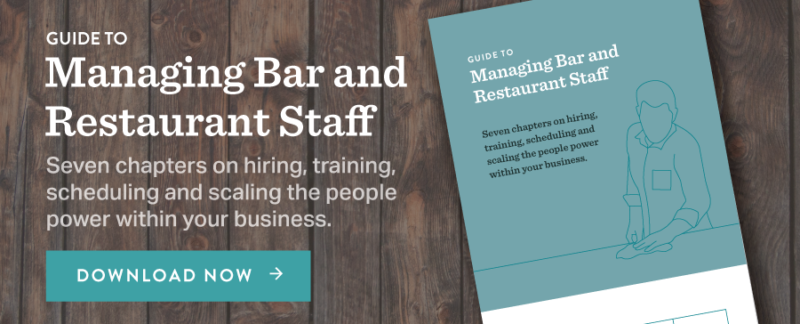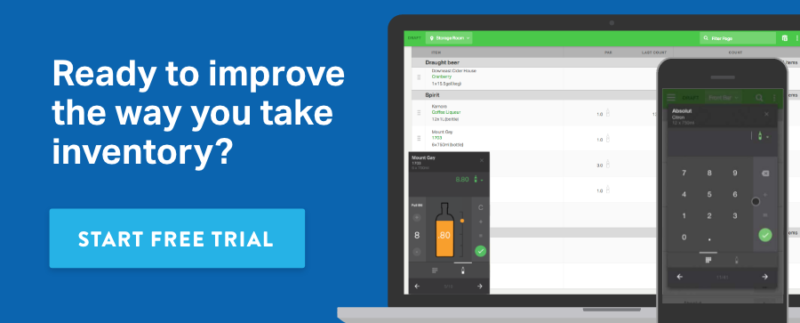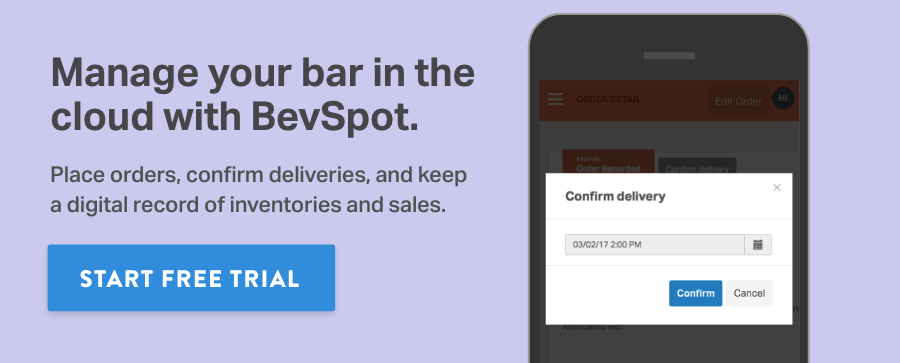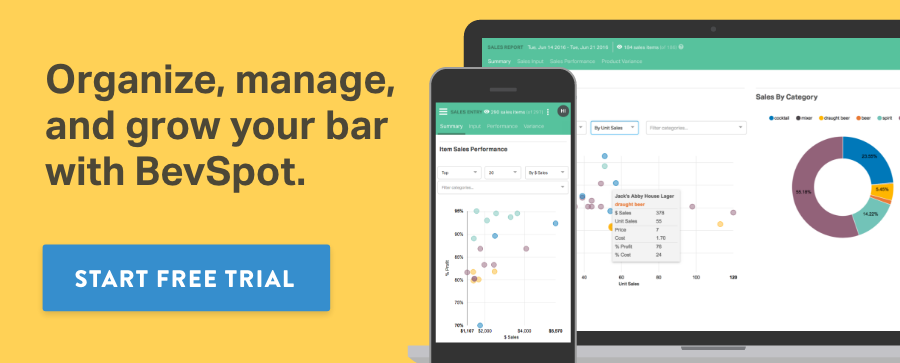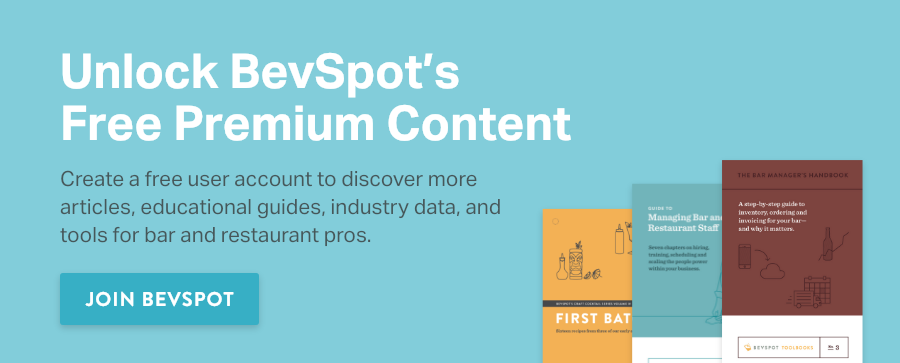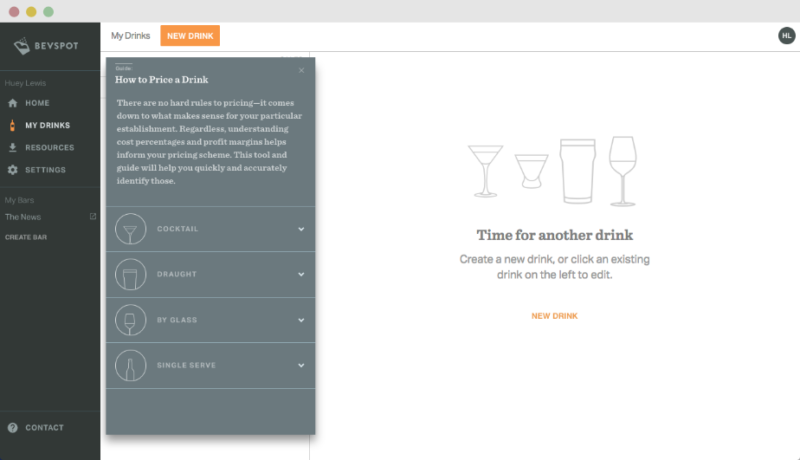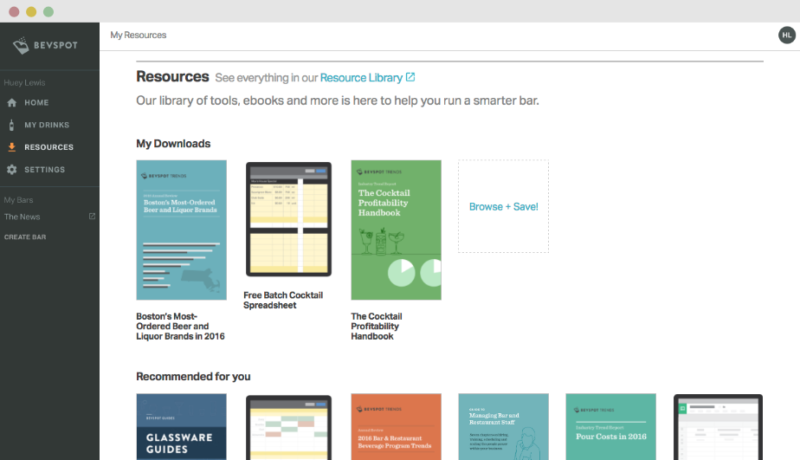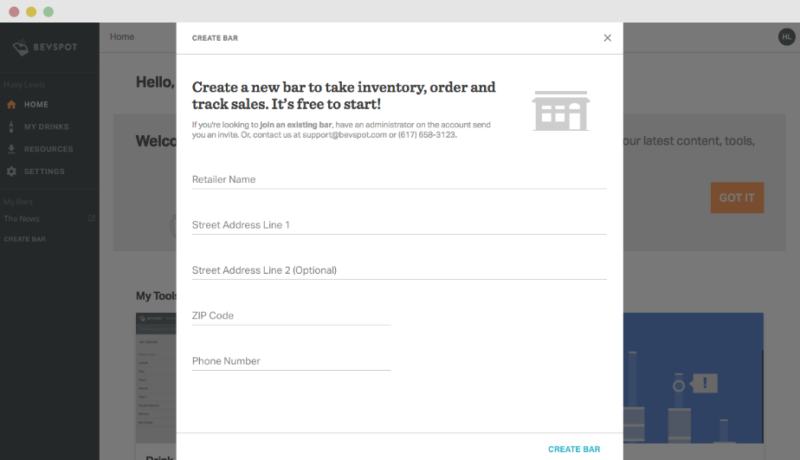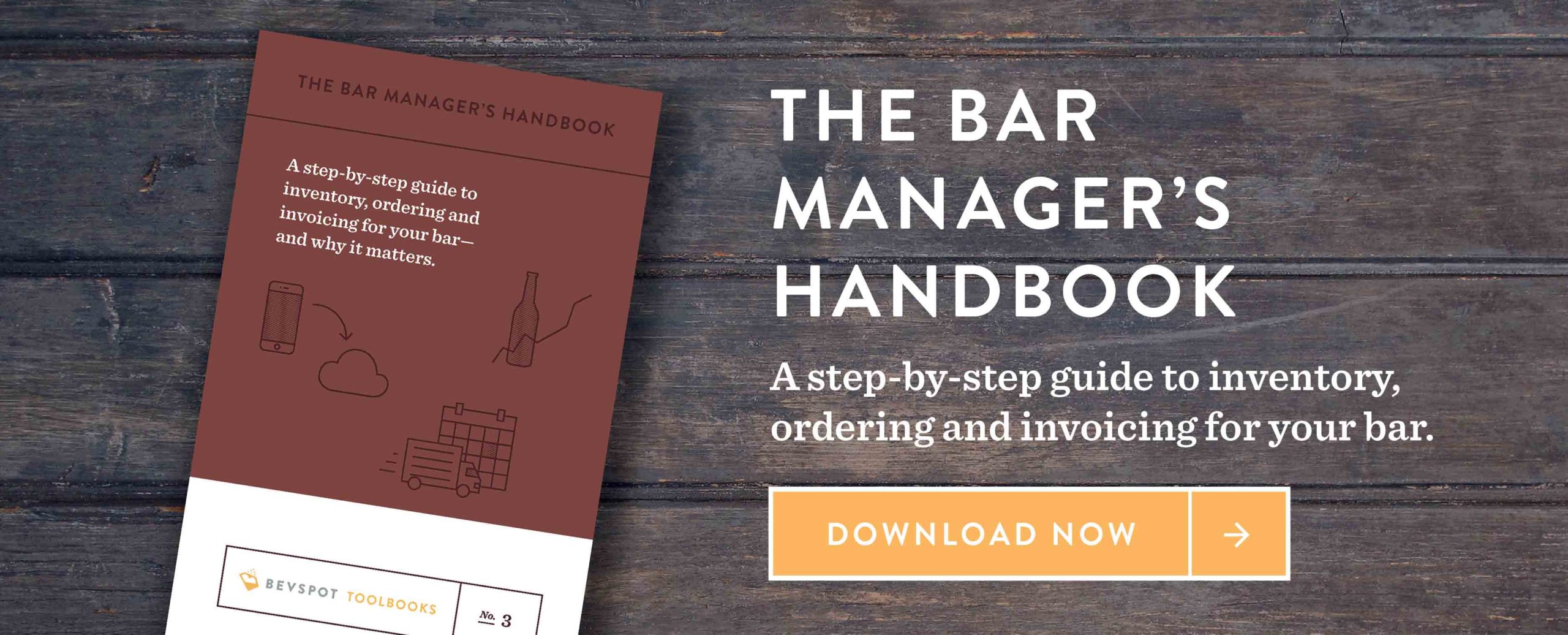3 Tips For Managing Conflict Resolution With Bar Staff
It’s time to talk about a subject every single person on this planet deals with: conflict.
Whether a hostess, a brewery owner, assistant manager, the president of a country… with seven and a half billion people on Earth, we are going to find ourselves getting in each other’s way. Especially in our industry where we are speaking to so many people throughout the day: we have to be on the ball and ready to go at a pace that less customer-facing industries don’t experience.
How do we create better conflict resolution?
Hello and welcome to the wonderful world of Human Resources (HR). I’ll be your guide today.
Briefly: “conflict resolution” generally refers to procedures for dealing with employee complaints. It can be as simple as, “Where should this new shelf be installed in the bar?” with a discussion between bar staff and a manager or something more formal like progressive disciplinary resolution.
For the most part, at organizations that have these policies or management training in place that includes a strong dose of conflict resolution, employees will see their employer as fair when conflict does arise.
Even the smallest of businesses do best when they have taken the time to learn about conflict resolution behavior and procedure. Depending on the size of your company, you’ll have an employee handbook that lists how work conflicts are to be handled. If you’re at a smaller joint, you probably don’t have a handbook, and the most you need to concern yourself with is documentation from a bureaucratic standpoint. The rest will be on you as another person and as a manager/owner to guide the conflict from there.
To educate yourself further, I highly recommend checking out Society For Human Resource Management (SHRM).
Let’s start with a situation many of us have experienced in some form:
An employee has been disgruntled for a while. Some of them are their own personal issues, some of them are legitimate problems from the company.
The biggest problem for the company is the way they express their issues openly and with hostility. Multiple employees have approached you and other managers about this employee’s attitude. You’ve noticed a drop in other employees’ work behavior, and even the other managers seem reluctant to be around the bar for long. You’ve even experienced this negativity directed at yourself and guests.
The employee has great technical abilities. They are organized and clean well. When they aren’t bad-mouthing guests or bullying employees, they seem to be okay, but most of that is when they are working alone. Their interview was fine, and they came with management experience as well. Nothing in the interview or on paper was off, and their training also went off without a hitch. Yet, you have conflict. How do you solve it?
Tip 1: Start Listening and Learning
When an employee is creating negativity like this employee, you have to move fast, and you have to be respectful not just to the company, but the employee. It’s not about your personal feelings, but about the professional atmosphere that the owner and management are in charge of maintaining.
Remember the employee is a human too. Validate their frustration and anger. “I hear you on this. I know I’m not behind the bar as much as you. Can we go talk about this in private/a different time (provide a specific time so they know you mean it)?” We all know the stereotype that management doesn’t help employees and is only out for covering their own asses. Prove this wrong. Even if all the employees point at the one hostile employee, remember it is a team.
One person may be mostly in the wrong, but it doesn’t excuse bad or fearful communication by all, especially management.
Tip 2: Don’t Gossip
Try not to engage in hearsay and gossip with other management or employees while getting to the bottom of things. You’ve spoken to the hostile employee and affected parties and heard them out.
If it’s personal issues, you aren’t their therapist and can’t give them advice on things outside of work, but you can let them know their personal life is affecting the workplace and you’ve noticed it and are concerned for them.
Don’t go sharing what you’ve learned with others even if other employees ask about what’s going on. While they may be affected by the hostile employee, that doesn’t give them the right to know what was said or exactly how it is being handled.
Tip 3: Document Everything
Partly because it’s helpful with unemployment laws, and it establishes order for others down the road. Document conversations you have.
By the way, documentation goes both ways—employees, you can document too. I highly recommend employees document situations as well in case you do end up with job loss. The more information you can supply the unemployment office, the more likely you’ll see some kind of restitution. Paperwork isn’t thrilling for anyone, but it is the best way to deal with the system currently in place.
These three tips are just some ways to create conflict resolution policy. You’ll find most conflict resolution policy progresses something like this: a talk (not necessarily documented), a verbal warning, a written warning, a final warning/suspension, and finally, letting the employee go. Often these can be jumped around depending on the conflict, but with behavioral issues, this kind of progressive action allows all parties to be human and grow and learn in this experience.
On a personal note, empathy and compassion go a long way, even with employees who aren’t thrilled with you and the company.
To Summarize
I’ve learned that dealing with situations like the one above should not result in outright firing as the best way to handle work conflict. That doesn’t mean that sometimes firing someone is the best solution to conflict, but try to make it the last resort after all other options have happened/been considered. It’s extra money and work to have to fire, hire, and retrain someone and get them to the level you need. Not to mention turnover can impact team morale and company culture. It’s less of a headache, and definitely less costly, to sit down with the employee, with the team, and with your boss (unless you are the head honcho), to get a better idea of what’s going on.
The hardest part of it all? Getting them to trust in the process and in you. All of us have worked with people and management who haven’t had our backs. Who have said, “You can tell me anything”, and that has turned into work retaliation or discrimination. You have to address that real fear and validate that your employees might not be okay with speaking up in a group setting. Part of keeping work conflict at a minimum is being invested in your employees and your management team as individuals from day one.
Have questions or comments about conflict resolution policy, a story to share, or HR matters? Let us know in the comments section below.
For more info on managing bar staff, make sure to sign up for a free BevSpot Community account to stay up-to-date on the latest articles as well as gain exclusive access to free resources.
Schedule 15mins to chat with a product specialist
Start a FREE Trial Today! BevSpot offers full product education and account setup for all customers! No card Information needed!
Press Release: BevSpot Integrates with Upserve to Help Hospitality Industry Streamline Efficiency
Boston, MA – BevSpot, a fast growing software company changing the way bars and restaurants do business, today announced a new partnership with Upserve to better serve the hospitality industry.
By integrating Breadcrumb POS by Upserve as a partner in the Upserve Marketplace, BevSpot strengthens its core mission to give users the ability to leverage their data to make smarter, cost-saving decisions for their establishment. It does this by now combining detailed item-level sales numbers from your Breadcrumb POS with the inventory and ordering data already stored in BevSpot.
“Bars and restaurants are constantly looking for new ways to streamline operations, whether they’re taking inventory or sending out and tracking liquor orders,” said Rory Crawford, CEO of BevSpot. “In joining the Upserve Marketplace, we can now provide an even greater depth of data and analysis to help people spend less time head down in the books and more time giving customers a better experience. We’re thrilled to join the Upserve community as members, but even more excited about what this means for our users.”
BevSpot’s cloud-based software, which is easy to use and requires no contracts, can help bars and restaurants reduce the time it takes to complete inventory and ordering, provide real-time performance insights, and more. This mission aligns well with Upserve’s own goal of offering restaurant owners and operators one platform from which to run all aspects of their businesses.
“The ease and intuitive nature of BevSpot’s software make it a perfect fit for the Upserve Marketplace,” said Dave Hoffman, vice president of business development at Upserve. “Understanding this type of data is really invaluable. Together, we’re going to only help bar owners and managers elevate their businesses to new levels.”
Bars and restaurants interested in learning more can find us at 1-617-658-3123 or contact@bevspot.com.

About BevSpot
Founded in 2014, BevSpot exists to make your daily operations a little more sane and optimize your business for growth by making it easier to take inventory, digitize invoices, sending out and tracking orders, and more.
Though a young company, it has been growing fast and to date boasts more than 4000 users in the hospitality industry with more signing up all the time. Bars and restaurants interested in learning more about BevSpot’s software can learn more at BevSpot.com.

About Upserve
Upserve is the magic ingredient that helps restaurateurs thrive, putting everything they need in one place. In a single platform, Upserve offers the market-leading cloud point of sale for restaurants, Breadcrumb POS by Upserve; actionable analytics through Upserve HQ; transparent processing with Upserve Payments; mobile restaurant management with Upserve Live, and seamless integration with leading third-party restaurant apps via the Upserve Marketplace. Thousands of restaurants use Upserve to manage relationships with more than 32 million active diners, process over $11 billion in annual sales, and serve over 23 million meals per month. Upserve is headquartered in Providence with additional offices in San Francisco and New York City.
For BevSpot users interested in learning more about our integration with Breadcrumb POS, feel free to check out this page for more information.
Understanding Shandy: Where Does Summer’s Most Refreshing Style Fit in Your Program
You need more than nice weather and sunshine to sell this refreshing brew.
The spring and summertime mean much more for bars and restaurants than longer days and warmer weather. Critically, this is the time of year to update draft lists and menus to highlight more refreshing beers to help customers beat the heat. Because when it’s 80 degrees out, your average drinker doesn’t want a barrel-aged imperial stout.
As such, it’s all about refreshment. And it’s hard to think of a beer more synonymous with the warm weather months than the shandy, a pound-able, low-ABV libation made traditionally by mixing beer with lemonade or citrus soda.
But it’s not as simple as stocking a popular shandy brand and cashing in. The style has grown increasingly popular in recent years, yes, but those that make it say there’s still a lack of awareness out there. Because it’s a hybrid product of sorts, servers might not know how to answer certain questions. Such as: Is it a cocktail? Is it a flavored malt beverage, in the vain of Lime-A-Rita? Is it something else entirely?
“It has gotten more confusing since the flavored malt beverage space has grown,” says Cara Lauritzen, associate marketing manager for Leinenkugel, which makes Leinenkugel Summer Shandy. “There’s just more and more flavors, so people are confused.”
Therefore, bars can stand out from the crowd by cultivating a deeper understanding of both the style and the unique differences between individual products. With that, it should become easier to answer the key question of where the shandy fits in a given bar program.
Familiarize Yourself with the Style—and the Individual Brands
On that first note, rest assured: Shandies are first and foremost beers. Bartenders can make them like cocktails with some mixology at the table, but those packaged for wide availability are brewed to taste the way they do. As in, they aren’t stable beers mixed after the fact and canned. Because many are made differently, however, talking about the style alone is simply too general a descriptive umbrella.
More than knowing the style itself, then, it’s vital for bars to know the individual brands on their menus.
Take Narragansett’s cult favorite Del’s Shandy, for instance. The company makes the product using its own lager as its base beer. This may not sound like a differentiator, but it is. “Using that, it’s different from every other shandy,” says Mark Hellendrung, company CEO. “Most are wheat beers.” (Many wheat beers already lend themselves well to a slice of orange, making them a nice compliment to citrusy flavoring. You wouldn’t typically drop an orange wedge in a ‘Gansett lager.) Further, the lemon flavor comes from Del’s frozen lemonade, making the product a marriage of two uniquely Rhode Island brands.
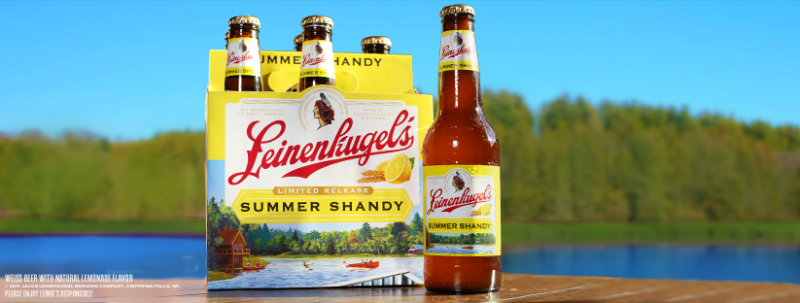
The above-mentioned Leinenkugel Summer Shandy, meanwhile, is the clear industry leader, with some research indicating that it accounts for nine out of every 10 shandies sold in the United States. In fact, speaking with Good Beer Hunting (full disclosure: I’m a regular contributor to the site), Jeremy Danner of Boulevard Brewing credits the company with making “Shandy a word that people know” at all.
This isn’t merely trivia. Those on the production side of things want these stories told.
But, most critically, bars and restaurants should ask: “Where does the shandy fit in my own program?”
The answer to that question will vary from place to place. There are a couple things to consider, however.
Yes, it’s true that the shandy isn’t explicitly a summer style. Traveler Beer Co. specializes in shandies and has a number of year-round and colder-weather releases.
“There are certain flavors that people crave, like pumpkin spice in the fall, and we’ve found that there’s a way to straddle refreshment with flavors of the season,” says Kathleen Barnes, of Traveler. “For example, we brew an incredibly popular fall beer called Jack-O Traveler Pumpkin Shandy. It’s still light with the low 4.4% ABV, but also has the flavor profile that people seek out in the fall.”
So, if one were interested in carving out a niche as the winter shandy joint, there’s opportunity there. Stylistically speaking, however, and despite the newer wave of year-round offerings, the shandy has a well-established reputation for being a summer beer. And for good reason, given the light body, low alcohol content, and fruity flavors typically associated with the style. So come summer time, producers recommend stocking a few different options, space permitting, just as the average bar would with an IPA (because these days, you need a handful of those, too).
“Any on-premise account that gets any sniff of a summer vibe to it, whether it’s a patio or just some place people go before a baseball game or something like that, you’ve got to have this style on,” adds Hellendrung at Narragansett. “And depending on how much space you have and how creative you want to get, you should have a couple in there.”
Take food pairing into account as well. Lauritzen, of Leinenkugel, recommends pairing the style with any lightly fried appetizer. The sweetness of the style can also balance well with saltier meat-based dishes
Whatever you do, though, just remember that shandies and radlers aren’t the same thing. But that’s a story for another day.
For more industry tips and info on seasonal beverages, make sure to create your own BevSpot user account to stay up to date with the latest articles and guides.
Celebrating Your Own Story: Trevor Driscoll on Gaggan
Trevor is a Customer Success Account Manager who’s been with BevSpot for nearly two years. He loves helping users, reading up on the latest openings, and crafting his own tiki-style cocktails.
So, what is a memorable experience you’ve had at a restaurant or bar?
One that comes to my mind instantly when you ask me that is my meal at Gaggan in Thailand.
How did you come across Gaggan?
I was traveling in Thailand for the second or third time. This was back when I was living in India. While I was there, I would travel to Thailand for fun sometimes.
This particular time, I was traveling with my family and they tasked me with finding interesting restaurants. They’re not active foodies, but they enjoy food. So, I looked around for something interesting and I came across an Indian restaurant in Thailand. He was doing Indian food in a way that intrigued me.
How did you find it intriguing?
It was a very elevated version of Indian food. Having lived in India for a long time, I definitely noticed that Indian food isn’t normally done that way. Even in India, nobody’s really doing that. I thought that it was fascinating that it was happening in Thailand. So, I was just really intrigued by that right off the surface. I ended up just making a reservation. It was super easy to get in, because the restaurant was on a top Asia list at the time.
The location was really cool, even driving up to it. It was not what you’d often expect for restaurants in Asia. They tend to be a little grandiose and have huge facades. This was a beautiful old house that was tucked behind a massage parlor. It was very low-key. There were also some candles outside.
When you walk into the place, it’s very white and beige with little pops of color. The decor was definitely atypical of most Indian restaurants. They tend to be very colorful, ornate, and a little over the top. My whole meal proceeded to be this really interesting experience that was more theatrical.
Was it coursed?
I believe the chef, Gaggan Anand, only does tasting menus. The meal really was an amazing experience, because you felt like you were part of someone’s journey. It was partly your own as well, because you were eating it and experiencing it. But, it was very much someone else’s.
So, you got that feeling that the chef was trying to tell you his own personal story through the food.
Yeah. It’s definitely not something you find often.
Especially for an Indian restaurant. Do you remember any of the courses? Do any of them stick out in your mind?
He had a lot of very good ones. I did a little bit of research on the courses after the fact, because Gaggan was in a show that I like to watch called Chef’s Table on Netflix.
Oh, I know Chef’s Table.
This was many years after I went there, so I remembered some courses after seeing that episode. And he trained with the guy [Ferran Adrià] at elBulli.
I remember this episode now. I know the place you’re talking about.
Yeah, it’s the last one in Season 2. So, Gaggan took some cues from elBulli. When you first sit down, he serves you a lot of things very quickly. A lot of quick interesting bites.
One of them that sticks out in my head is a yogurt ball that is similar to a traditional North Indian-style street food item. That immediately appealed to me, because I had lived in North India for a long time. So, it was very cool to see this stylistic approach to it.
Would you describe it as a modern take on it?
Yes, it was a modern take on Indian food. I think that’s definitely his overall mission with this restaurant: to prove that Indian cuisine can be really cutting edge.
Do you remember any of the beverages you had there?
There were definitely some crazy cocktails there. A lot of things that utilized liquid nitrogen. It was an interesting choice. That kind of cuisine can be really cool, but it can feel kind of gimmicky as well.
In some of the other restaurants where you see that done, it’s like “This is cool and it looks pretty, but I wouldn’t come back for it.”
Or where the details and flavors don’t stick into your mind. Only the gimmick does.
In comparison, this style felt more purposeful and much more thought-provoking than you might expect from hearing someone describe it as molecular gastronomy with Indian food.
That’s essentially what it was, but Gaggan’s approach really mattered and stood out.
So, because it felt more personal, you could connect to it on a deeper level.
Definitely. And I had this great waiter who’s probably the most bombastic and crazy waiter I’ve ever had. He literally put some food into some of our mouths.
…he baby-fed you?
It was totally over the top and wild. He was a very interesting guy. We ended up learning his life story throughout the course of the meal.
That’s such a risk for a server. It definitely wouldn’t work in some places, especially where people value their privacy a lot more. Particularly in America, it’s often more “This is my/our meal. I’m not here to interact with other people.”
You definitely touched on that in the first conversation in this series.
My family comes off as more American, where this meal is more our own family time. But, when you come to a place like Gaggan, you kind of throw yourself in there and are ready to experience something new. This waiter definitely added to the experience a lot.
Did you feel the atmosphere was different than what you’re used to because of that? Did you interact at all with other tables?
You do end up peeking at what other tables are doing, because the dishes are crazy and eye-catching. But we didn’t really directly interact with other tables.
Here, you end up focusing a lot on your own meal, because there’s a lot going on in front of you. Visually, it’s actually difficult to take in what’s happening. So, you end up focusing inwards on your own experience.
Did you talk to the chef at all?
The chef came out and introduced himself. We chatted for a little bit, which is something I always love. It’s something you don’t see in a lot of places.
That can be pretty rare. In fine dining, the chefs can get stuck in the weeds and some will only go to VIP tables.
With Gaggan, you can see that the chef is super excited about what he’s doing. He’s the type of guy who really wants to go out and talk to everyone.
You can tell from watching him that some of the people in the restaurant had met him a couple of times and he’s clearly doing this often. It wasn’t just a lucky night that we got to talk to him.
That kind of outreach really depends on their personality. Some chefs can be reserved and just want to do their thing in the kitchen.
Definitely. But, as a guest, I’ve always appreciated that interaction. It always made it more special to me.
Was there anything else that stood out to you about Gaggan that separated it from other experiences you’ve had?
To break it down, I think that Gaggan was just a fusion of a lot of my personal interests. It worked really well for this particular meal. All together, the feelings I have about that experience has always been something I’ve looked for in other restaurants.
Trying to find an experience like Gaggan can be really hard to replicate though.
This is true. It’s also unfortunate that to get meals like Gaggan you have to spend a lot of money. In Boston, you could go to a place like Shepard and maybe get a similar experience. But, those aren’t things you can go to often and you can’t really experience it with a large group of people necessarily either.
Read more of our guest experiences and make sure to create a free user account to stay up-to-date on the latest BevSpot articles and gain access to exclusive reports and guides.
Seeing Red: Red Flags In Hiring Bar Staff
No matter your industry, we’ve all worked with the employee who should never have been hired.
We ask, “How did they even get past the interview stage?” We grumble about how HR or the hiring managers should have better vetted the interviewee. We are left with a negative environment and disgruntled workers all around. Whether it’s a bad manager or a bad bartender, problematic employees bring down the team and can lead to long term internal issues. It’s difficult because so many candidates do know the rights things to say. It doesn’t mean their stories aren’t true, but it also means they lack self-awareness.
Part of that is on them, but the bigger part is on us, the hiring managers, to know that something in our hiring system is a problem. Through years of trial and error, I’ve found the biggest change we can make to the system is the questions we ask.
I reached out to longtime industry professionals and hiring managers, Tyler Lymer and Jeff Terry. They shared stories of when they spotted red flags and gave questions or answers they found helped bring out some red flags during the interviewing process. Hopefully, you’ll find some amusement and insight from them.
Loren: Tell me a red flag story.
JEFF:
The biggest red flag I had was a person interviewing for a cocktailer/bartender position. While she was waiting, maybe 8-10 minutes while I was finishing up another interview, she ordered and finished a shot and a beer before she told my bartender that she was waiting for an interview. I saw this from where I was sitting and thought she was just a customer.
Did you still have the interview or tell her what she did wrong?
JEFF:
Yes, but I did shorten it. As I was closing the interview, I mentioned to save tasting the cocktails for after the interview.
TYLER:
Recently, I had an applicant keep asking about money and compensation more than twice during an interview. That was an immediate red flag.
I understand he wanted to know what/how he was getting compensated, but there’s no need to ask more than once and for clarification if need be. It tells me as a manager that this person is only looking out for themself/to collect a check and won’t make a good team player at the end of the day.
What are some examples of questions or things a hiring manager should pay attention for when it comes to interviewing?
TYLER AND JEFF:
Not being prepared. Bring a pen!
JEFF:
First impressions are critical. As I said in the story, don’t order a beer or cocktail. Yes, this has happened several times. I will say leaving a tip for the bartender or server that offered or served you a water/coffee/soda does get my attention. Showing up on time. If you’re going to be late, please call and ask to reschedule or if you’re no longer interested, call. Don’t just not show up. It’s good to confirm location and time over the phone–saves everyone trouble.
Dress appropriately for the location. Be mindful of the place you’re interviewing at. Craft bars dress differently than a strip bar or dive bar. Details matter.
What about the interviewing process?
JEFF:
I also like the two interviewer process, either same day/time or have them come back after the initial screening. Some questions will be redundant, but it gives us a better feel about tendencies and to see if you are consistent. It also makes it so there are more people involved so it’s not just one person making a decision. It’s more team oriented.
TYLER:
So, one of the biggest things I try to look for is passion. If someone is passionate about something, how does that translate into what they would be doing on a daily basis. The other part to that is through this passion, have they demonstrated a willingness to learn, grow, and develop? In other words, it’s culturally a deal breaker when someone is only in it for the money or you have an industry professional who knows it all and isn’t receptive to discourse and change.
Turns out, Tyler, Jeff, and myself all have commonalities in what we look for: Passion, team-mindedness, honesty, and personal accountability. (Hmm, this sounds familiar.)
One final note: Make sure your questions and actions in interviewing create space for your candidates to be in-depth and honest with you. Likewise, demonstrate the same. You are more likely to find those red flags of bad behavior, disrespect, and intolerance when your questions go beyond the surface.
Also, it might not be your job to tell a candidate why they didn’t get the job or why you are ending the interview early, but I’ve learned critical feedback is rare. If we want to get better candidates, we need to start also letting them know why things didn’t work out. Whether it’s a bad choice of outfit, showing up late, disrespectful behavior…etc., if nobody is saying anything, we won’t see more growth, and the red flags won’t decrease.
We know it’s not a one size fits all, so, if you have any successful questions you’ve used in interviews or any more examples of red flags you ran into, we’d love to hear about them in the comments section below.
If you liked this article, be sure to sign up for your own BevSpot account to stay on top of the latest bar management tips and industry insights.
Schedule 15mins to chat with a product specialist
Start a FREE Trial Today! BevSpot offers full product education and account setup for all customers! No card Information needed!
8 Things to Consider for Your Patio Bar
Is there any better feeling than sipping a cold, refreshing beverage outside on a gloriously sunny day?
In New England, as of May those days are still intermittent, with fickle Mother Nature alternating between monsoons and record highs; but already local outdoor-friendly bars and restaurants are starting to dust off their patios and decks and bring out their sidewalk tables and chairs to serve tasty cocktails, wines, and beers to guests al fresco.
Whether you’ve got a full-fledged large setup with a dozen large round tables with umbrellas, to the few tiny cafe low-tops the city permits you to have on busy city sidewalks, or even if you’ve just got huge windows you can finally open up to the fresh air—harnessing that beautiful summer sunshine is where it’s at. Here in the Ocean State, we are fortunate to be gifted with myriad opportunities for seaside or waterfront beverage enjoyment. Some bars are located literally on or over the water, which can pose its own issues when hurricane season arrives. I’ve put together a few key things to consider for outdoor beverage consumption from a guest standpoint:
1. Optimizing space (and views if you have them)
Before Midtown Oyster Bar opened in my hometown of Newport, RI, its owners renovated the old Thames Street building into a multi-level establishment with three dining rooms, two bars, and two roof decks which were obviously constructed to compensate for neighboring buildings to give the best view possible of the nearby harbor.
2. Preparing for weather
Summer rain showers can arrive spontaneously. Make sure that there is adequate rain protection coverage for sensitive bar equipment and tables where people might be enjoying food. I remember eating a magnificent lobster roll on Matunuck Oyster Bar‘s famous waterfront terrace one time when a full-on monsoon started pouring from the skies! Fortunately, the restaurant had its heavy-duty plastic see-through awnings and temporary walls in place to keep out the rain, but it was still very dramatic—although certainly memorable!
Another time in Newport, my family had a much less pleasant experience when we were eating out at a restaurant I won’t name whose floors are highly vulnerable to rainwater and flooding; we were quite literally sitting in puddles. Make sure that when making use of your outside space, you take weather into account.
Sometimes, even in the summer, nights can be chilly in certain parts of the country—especially near the water. Outdoor heating lamps are typically a smart investment or the swanky hotspot Rooftop at the Providence G uses chic modern fire pits for its guests to relax around.

3. Safety always comes first
Depending on your clientele or type of bar, serving drinks in glasses outside can be a really bad idea; plastic is usually safer, but in more upscale establishments it might be in poor taste.
Make sure as well that bathrooms are available, accessible, and clearly marked depending on the size of outdoor crowd you attract.
4. Minding the wildlife
Bugs can be a major problem in some areas. Nothing ruins an evening worse than coming home with mosquito bites or to have gnats, flies, or bees buzzing around your drink. Mosquito magnets can be a smart investment in certain places.
And, although flowers are lovely, they can also attract bees, so try not to cultivate them in areas where guests will be standing or sitting for long periods of time.
5. Make sure it’s all legal
You will have no doubt researched your local laws and restrictions for your own establishment, but make sure that they are adequately enforced, which sometimes might require bringing in additional seasonal security.
In Providence, it is sometimes legal to bring drinks onto the sidewalk in front of the bar provided that there are tables outside for sitting and it is part of the actual premises, but alcohol cannot be taken outside of certain parameters. Make sure you’ve done your due diligence.
6. Consider rules for/against smoking
I am just old enough to have briefly experienced the bar scene in New England as a legal drinker before the law pushed cigarette smokers outdoors, and I have to say I don’t miss coming home after a night out with my clothes reeking of smoke.
Depending on where I go nowadays, it seems that some bars permit outdoor smoking in certain areas, and others don’t. Of course the comfort and safety of your guests should be foremost, and you also don’t want smoke wafting into the establishment, which is more likely to happen during summer months if windows or doors are left open to let in the fresh air. Again, just keep an eye on it and make sure that any smoking-friendly areas make sense given your layout and are up to code with legal restrictions in your town or city.
7. Manage noise levels as best you can
This issue is similar to smoking concerns; if your neighbors complain enough, you could get visited by the police. Make sure that you are abiding by local codes and operating within the parameters that apply uniquely to your establishment.
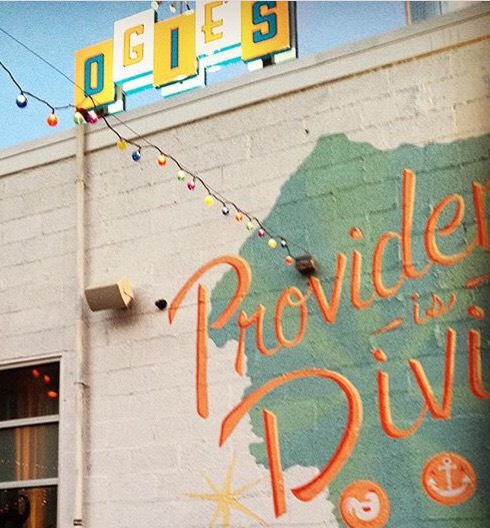
8. Be creative and stand out from the crowd
Assuming you’ve done your homework and ironed out all of the issues mentioned above, there are plenty of fun, creative ways that you can attract more patronage through celebrating the great outdoors in your own unique way.
Here in Providence, Rick’s Roadhouse is a go-to for cornhole, the Rooftop at Providence G showcases regular live music at nights, E&O Tap has occasional crayfish boils when the crustaceans are in season, and Ogie’s Trailer Park opens up its popular outdoor tiki bar: the perfect complement to the fake trailers and kitschy neon palm-trees of its 60’s Los Angeles trailer park-inspired décor.
Whether your view is of ocean waves or city streets and whether you’re a hole-in-the-wall or a multi-level juggernaut, there are always creative ways to make the most of the summer heat while keeping your guests cool with delicious seasonal beverages.
Schedule 15mins to chat with a product specialist
Start a FREE Trial Today! BevSpot offers full product education and account setup for all customers! No card Information needed!
The Most-Ordered Beer and Liquor Brands at Mexican Bars
With Cinco de Mayo on the horizon, what’s behind the bar at your local Mexican watering hole?
It’s undeniable that Mexican food and beverage culture has been a notable thread of the American food and beverage industry for generations. With the emergence of Mexican restaurant chains such as Taco Bell, Qdoba, and Chipotle coupled with the general proliferation of Tex-Mex cuisine, it’s become more likely you will have a taqueria or cantina of sorts in your neighborhood.
In fact, over 30 of our users across 17 different metro areas identify themselves as Mexican-style bars. In celebration of Cinco de Mayo, we dug a little deeper into our data to see how these bars distinguish themselves, based on their ordering habits and general beverage program choices.
The following material aggregates a year’s worth of on-premise liquor and beer ordering data ending in March 2017. All figures represent percentages of orders from distributors in dollar terms.
Cocktail Catering: The Story of Little Bitte
A true story of grace and grit, here’s the tale of Little Bitte…
After moving back to Providence a few years ago, I began seeing posts about Little Bitte Cocktail Artisanal Cocktails catering service pop up on my Facebook feed; my friends were RSVPing to their workshops about bitters, craft cocktail-making, special daiquiris and floral crowns. Little Bitte’s lush imagery and elegant aesthetics drew me in, even as I wondered exactly what a cocktail caterer was, or what made it different from a standard bartending service.
I decided to go right to the source and find out more.
The Earthly Genesis of Little Bitte
I met up with Little Bitte owner Willa Van Nostrand at Pastiche for coffee, tea, and rugelach.
The first thing I learned about her is that she grew up on a little herb farm in Rehoboth, MA, which cultivated a lifelong fascination with tastes, flavors, and how different ingredients interact. Willa started bartending in college and quickly developed her mixology skills at many bars in Boston and Providence.
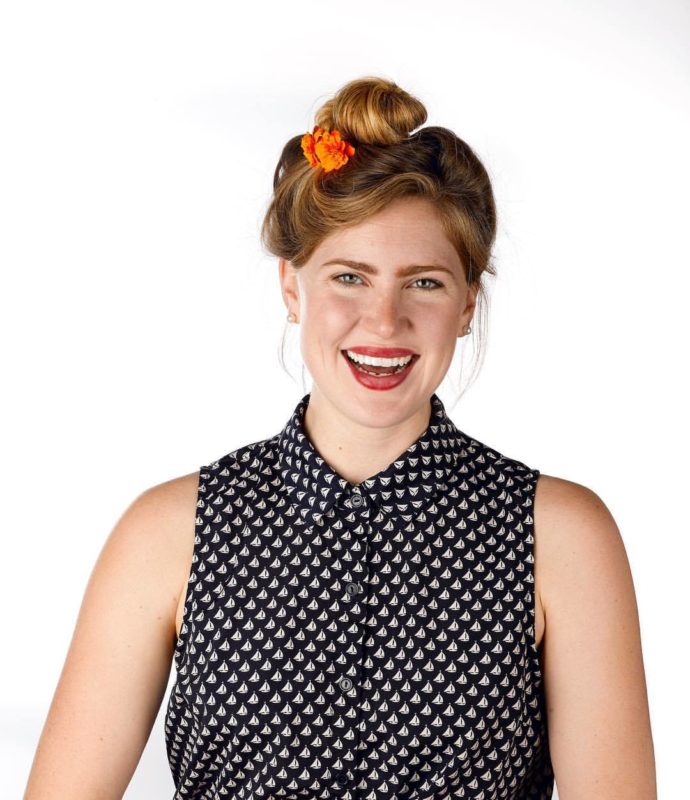
She often attracted attention thanks to her creativity and passion for experimentation. “One day I would show up with edible flowers, the next shift I would be fresh-juicing my own pineapple,” Willa said. “To keep my mind interested and learning and excited, I needed to add my own touch to things and to keep that fire burning. Slowly but surely, I developed a following of people who came to visit me, and then some would start asking if I could come to their parties and bartend.”
Those small bartending gigs became the origins of Little Bitte, a play on “little bit” with the word “bitte” meaning “welcome,” “please,” and also “thank you” in German—and perhaps also sounding a bit like “bitter” in the German tongue. To Willa, the word embodies a throwback to the golden age of the cocktail era: a little bit of manners mixed with fine spirits.
Little Bitte’s Elemental Growth
As her bartending engagements increased, Willa found that she needed to enlist friends in the industry to help with larger events. Soon, she sought to legitimize, incorporate, and get licensing for what became Rhode Island’s first-ever cocktail catering company, coming up with signature drinks and new spins on old classics with an emphasis on small batch artisanal liquors, liqueurs, bitters, natural wine, and locally-sourced garnishes and fresh-squeezed juices.
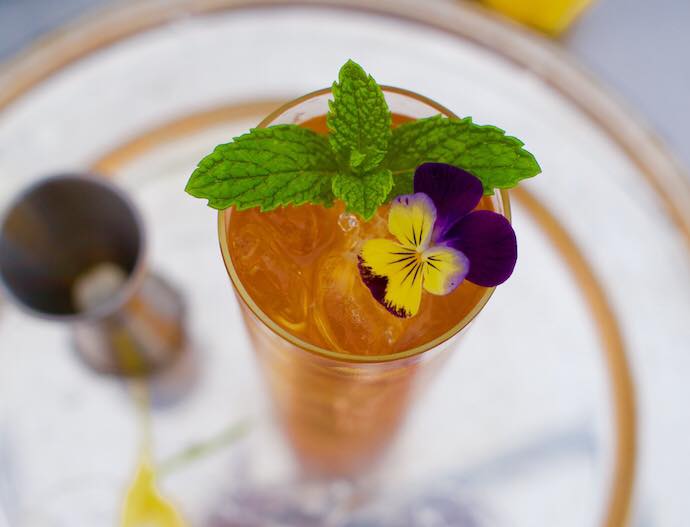
Another pillar of Little Bitte is the aesthetics I mentioned before: a gorgeous bar, dazzling drinks, and every detail perfected down to a meticulous tee. “My background is in visual art and theater, and I wouldn’t have been able to build this brand if I hadn’t followed my gut and visions for the bars we create,” Willa said. “I studied improv, classical acting training, lighting, sets and everything; it’s very much at the heart of what I’m doing.”
Willa caters events ranging from just her with a tiny bar, all the way up to up to 20 mixologists, but the average is six. They are generally friends she knows locally from the industry, many of whom are also artists and musicians—but all are naturally personable. “For me, the personality is first and foremost: a generosity, openness, and willingness to participate and speak with the clients,” she said. “If they have that wish to learn, they’ll learn really fast, and each season will teach them more about mixers and modifiers.”
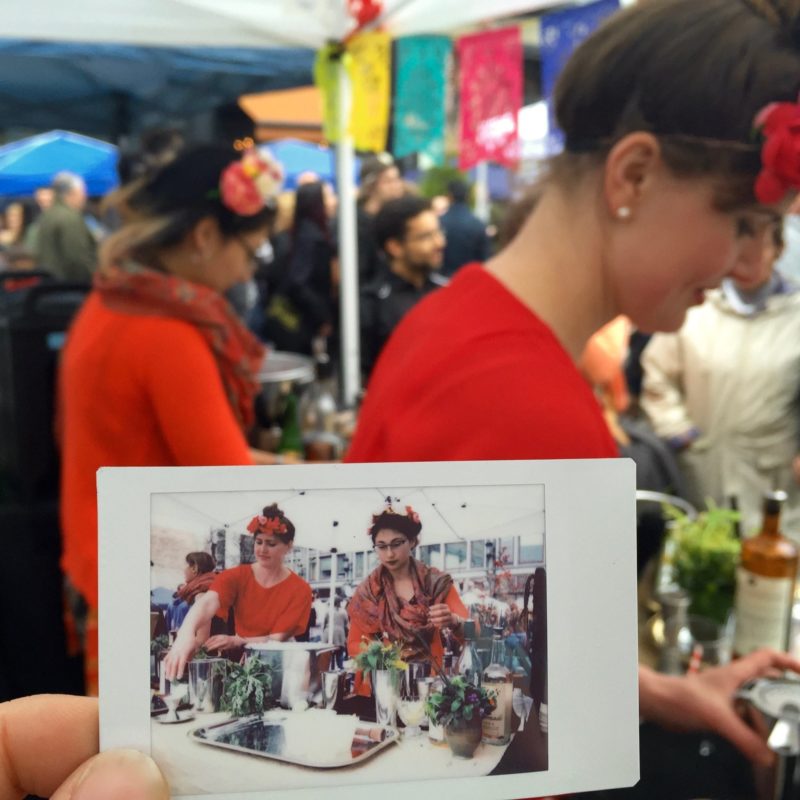
Most of the events she caters are wedding-related, working with a couple for sometimes over a year leading up with the big day, but she has also catered fundraisers for local nonprofits, festivals, runs a booth at Providence’s Waterfire, and worked with schools and colleges in the area.
To my surprise, Willa has never paid for advertising or marketing of any kind—all of her business has come from word-of-mouth and organic exposure. Willa herself is a writer for online Puddingstone Post and local food magazine Edible Rhody contributing as a cocktail expert, which no doubts help to boost her company’s image in the eyes of consumers. Willa has been committed to growing her business sustainably, and, because it is seasonal, she spends the off-months traveling, writing, consulting, and preparing. Recently, she’s been in the early stages of putting together her own cocktail recipe book.
Looking Beyond the Roots of Little Bitte
Although she loves what she does, Willa was up front with me about the daunting amount of work required: “I call catering ‘The Great Schlep’: you’re constantly moving heavy things, loading and unloading. Then you do it all again in reverse, to clean and store it,” she said. “I love catering and the act of popping up, but all the client sees is this beautiful vibrant bar, this oasis of beauty and fine drinks, a crew of put-together gals and guys with a pop-red lip or bow ties shaking cocktails; they’re not seeing the work that goes into it. It takes me two days to source materials, going around to all of the farms and finding what I need, and those long kitchen hours and days of prep.”
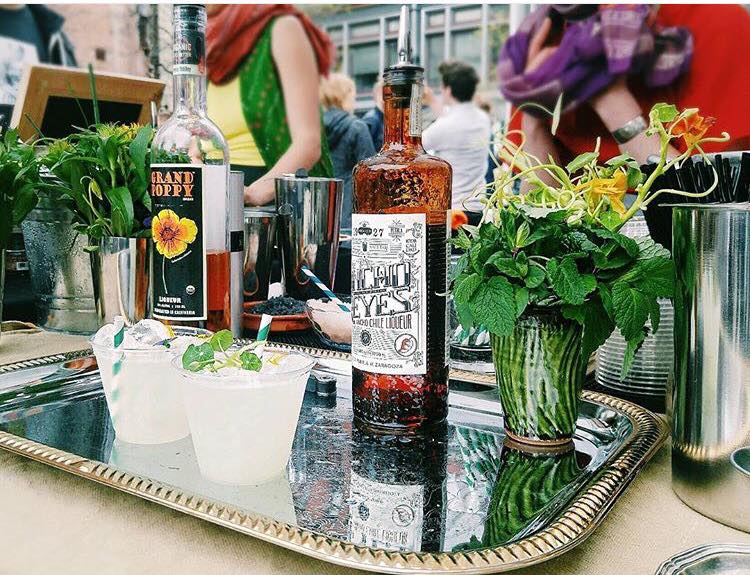
The other massive obstacle that goes unseen by most clients was the decade-long process of negotiating licensing and liability under RI state jurisdictions and the health department. She has also never sought help from investors. I asked if she’s worried that other people will try to emulate what she’s done, and “It’s starting. And it’s creepy but, yeah, of course,” she replied.
“I wouldn’t actually recommend catering to anybody,” she continued. “This is not the life I envisioned for myself, and that’s okay, it’s great—it means I’m growing and learning with my craft and creativity and my own artistry. If you’re driven and an entrepreneur, you’re going to find your niche and forge new territory. Staying independent has allowed me to remain open to collaboration with people making other kinds of drinks or food.” Going in without investors has meant plenty of challenges and difficulty, requiring “hard-headed fortitude and bootstrapping,” she said, “but, for the most part, people seem to really click with what I’m doing, and I’m still inspired by it, so I know something’s working!”
Schedule 15mins to chat with a product specialist
Start a FREE Trial Today! BevSpot offers full product education and account setup for all customers! No card Information needed!
A Distributor’s Guide for Landing the Latest and Greatest Small Batch Beer
Craft Collective isn’t your average beer distribution house.
Founded two years ago in Stoughton, MA, the company’s portfolio doesn’t boast any considerable volume brands to lean on. Rather, Craft Collective exclusively focuses on small-batch brews and limited beers for which demand typically vastly outweighs supply. Think Trve Brewing from Denver, or Finback from New York City. In turn, the distributor says it typically sells out of its stock within a week of arrival. Which is to say, Craft Collective sells many of the products that craft-centric beer bars want, but can’t easily secure.
“It’s truly a different model with a different way of handling and delivering beer than kind of the existing legacy big guys,” says co-founder and president Bryan Ferguson. “We’ll be statewide by the end of May essentially. But, we scale differently. We don’t have thousands upon thousands of customers. We’ve got about 600 customers right now.”
As such, for bars and restaurants, particularly of the startup variety, that want a piece of the proverbial special keg, it can be sort of a “get in line” proposition. But, worry not, BevSpot caught up with Ferguson to get his advice on how bars can best position themselves to land the next limited brew the competition is clamoring for.
The following has been edited for clarity.
How do you as a distributor, especially one that operates with lighter volume, make a distinction that a given bar is right to partner with?
The things we look for are pretty straightforward. It’s folks that we can trust to take care of the beer, to understand the beer, to learn the story of the brewery or the cidery we’re working with, and places that are good at hand selling products to customers.
We also look around and try to see if it seems like the end consumer there is the type of person that seems to be interested in our beer, the ones going in looking for something new, something different. Cooler space is always critical, too, especially for these fresh hoppy beers where freshness and storage are important. We’re always looking for that kind of stuff. Practically, I think it’s pretty easy to identify a handful of customers in any given region.
Is there any extra effort establishments can make to stand out?
We tend to do really well with customers who find us. Folks who have gone out of their way to figure out who distributes a certain small brand that they have an interest in. By and large, those people become our best customers.
It’s pretty self-fulfilling thing if you think about it, right? It changes the dynamic. We’re not walking into a store pitching our wares to someone who may or may not be interested. They’re finding us, and so there’s already kind of a quiet understanding of what we do and what our portfolio is. So, from there, it’s pretty straightforward.
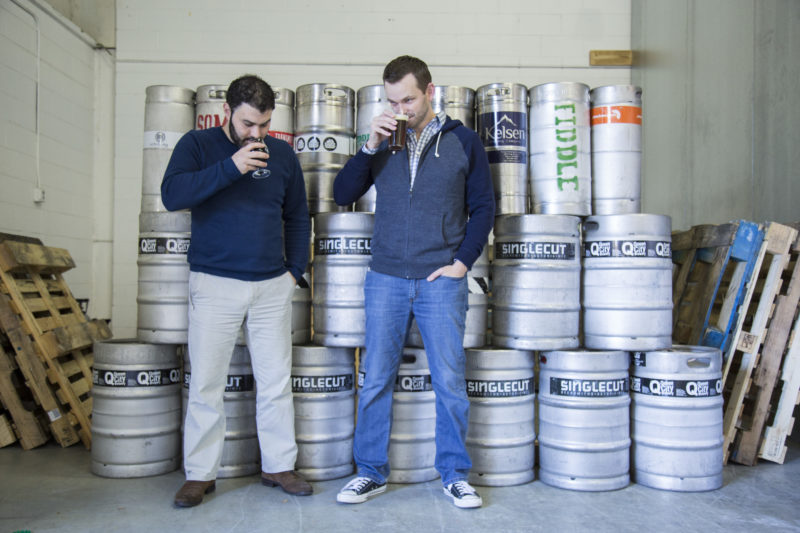
A young bar that’s maybe just coming online but maybe wants to be that new specialty craft destination – how should they go about trying to build a relationship with a distributor that specializes in carrying these lower volume, limited release products?
Show some enthusiasm. Show some interest in taking care of your draft system and learning about beer, curating a good list, and charging a fair price for a fair pour size. We’ll certainly find beer that makes sense for your location.
When 75% of your portfolio is expected to sell out, limited or whatever, our task becomes more just trying to place the right titles at the right bars, on the right draft lines, and in the right coolers. We’ve got enough to go around for all our customers to do meaningful business for all of them.
But, whether you’re getting Singlecut or Finback or Aeronaut or Oxbow or whatever, that’s something where we try to take a consultative approach and say, “Cool, we think this is going to work for you,” or “Hey, why don’t you try this thing instead?” I think by and large it works really well for everybody.
How do you make that determination that a brand might fit well in a certain bar?
It’s the nexus of price point, customer base, and style. A really well priced IPA by the pint works really well anywhere obviously. But, some places maybe have aspirations to do more than that and you take a stab at it. You sell them a more expensive keg, something a little more esoteric. Maybe it doesn’t move so fast, but then you’ve learned and you recalibrate and refocus, and over time you kind of figure out what does well.
What information can a bar give you to make that process seamless?
What role are we playing on your menu? Are we front and center? Are we just two draft lines, kind of in the esoteric corner of the menu? Are we the IPA that you plan to crush three half barrels of a week? We just kind of need to know where we stand and from there we can help you make really good decisions about your beer list.
Would you have any advice for establishments that might want to adjust their beer program but might not know how to do that?
Call us. [laughs] Share in kind of an open way with your distributor what your goals are. If you’re trying to move away from certain macro beers or certain “crafty” beers and you’re trying to do something more interesting, more local maybe, I think show a little bit of openness and share that with your distributor, with your sales rep. We all want the same thing. We all want to place cool beers at cool spots that are trying to do interesting things with their beer menus.
For more exclusive industry interviews and news, create a free BevSpot account to stay up-to-date on the latest blog articles and gain access to member-only tools and resources.
Draft vs. Bottle: A Data Breakdown of Beer Ordering Habits
A year of data reveals trends in the orders of American barroom patrons…
If there’s one thing that is known in the mythos of the American barroom, it’s that discussion, debate, and the occasional fistfight have been known to come about over a pint. Not least among these is the right and proper method of consuming the aforementioned drinks.
We’ve collected data from over 500 retailers across 40 states, researched brands and competing opinions, and attempted to distill which method of beer transport and dispensary reigns supreme. Before we get into the specifics and numbered data of how the fight shakes out, let’s cover the methods, their pros and cons, and why one might choose one over another.
The following data represents on-premise order data from the 12 months ending in March 2017. While the majority of retailers covered here are located outside of New England and New York, these particular regions are strongly represented in the data. Figures represent percentages of orders from distributors in dollar terms.
Improving Experiences with BevSpot’s User Accounts
How do you browse BevSpot’s website?
BevSpot might not mean the same thing to everyone. While our main product is our liquor inventory and ordering platform, we understand that many people purely find value in our content and resources as well.
In order to improve and enhance the experience for people who view our content and use our free tools, we’ve recently launched a new option (that you may or may not have noticed): individual user accounts.
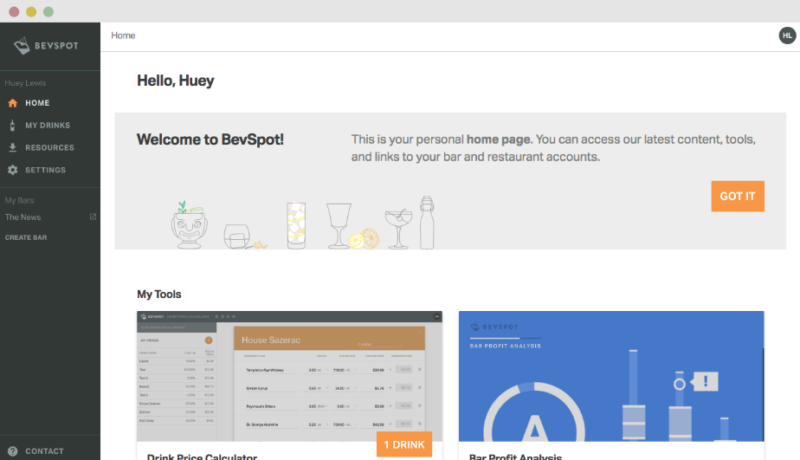
Now, when visitors come to BevSpot, they can create their own personal user accounts. This will also allow users of our inventory and ordering platform to seamlessly access our content and vice-versa. (Everything working together in harmony. What a novel concept, right?)
With the new user dashboard, we’ve also moved to allow people visiting our site to personalize their experience as they explore different areas. Let’s quickly break down our options thus far for users to navigate from their dashboard and why they exist:
My Drinks
Goal:
- Enable users to access our most popular free tool, the Drink Price Calculator, and their own personal list of drinks to enable fast tweaks to existing recipes or swiftly generate a new recipe on the fly.
This is our first step towards cultivating a structure to build on within our Drink Price Calculator. Future development on this popular tool is still in the works, so look forward to even more updates in the future.
Resources
Goals:
- Enable users to curate their own personal library of our resources.
- Enable users to track and revisit recently viewed blog articles as well as build a reliable list of recommendations for further reading.
- Create an easier way for people to access/come back to gated resource content.
This is a brand new way for people who visit the site to self-cultivate what’s really important to them in terms of what we have to offer. This will also allow us to learn from user preferences and push the creation of our resources in the right directions moving forward.
My Bars
Goals:
- Enable the quick and seamless transfer to and from the free inventory and ordering platform.
This is for the fans of our inventory and ordering platform. Retailer users can easily access their bar inventory and ordering whenever they like from any part of our website, since that’s kind of our thing.
TL;DR: We have a shiny new feature on our website that allows you to create a free user account and access different areas of the website more easily and in the way you want to.
Like what you see? Let us know in the comments below and give us your feedback. And look forward to more insight into awesome features in the near future. Cheers!
5 Essential “Soft Skills” for Great Bar Managers
The cocktail revolution has been here for quite some time.
More bartenders are capable of executing good versions of classic cocktails, and many are finding innovative ways to take cocktails to the next level. But, the hospitality industry isn’t just about the technique. Most of all, it’s about the people.
After all, hospitality isn’t something one accomplishes alone. It takes a team to execute (or fail at) great service, and it takes great management to lead the team. All too often, we promote senior people to management or those who demonstrate the most technical prowess. As a former hiring manager, I can speak to the issues I’ve seen when it comes to promoting for seniority or technical ability as the foremost quality.
By and large, the best leaders and managers I’ve found and worked with are those whose empathy and compassion were on display and handled well.
Cue the eye-roll and internal groan. You’ve all heard it before, “soft skills.” Yet, what is the major complaint we still hear from bar staff that isn’t about money? You guessed it: management and their inability to communicate and relate to the team.
A good manager will make or break a restaurant, more than any other role. A manager should be willing to do or have done all of the tasks they ask of their staff. Take out broken glass and garbage? Wash glassware? Make syrup and juice? No task is above a manager.
At my first bartending gig, I worked in a massive high-volume chain. Being left to my own devices became tedious after I’d explored as much as I could creativity-wise. I soon approached management and asked about moving into a different position or helping out in other areas, but those ideas were shot down with nothing to replace them.
If I called them for help or they were around, and I needed something, the usual response was to get a different staff member to do it instead of them, or they’d just ignore me. I decided if I ever became a manager, I’d never do that. Move forward two years of busting my ass (and a little luck), and I scored my first manager position.
Since then, I’ve identified five traits I find make for particularly skilled managers:
1. Trust
Perhaps, this is the most important trait of a good manager. You cannot build a team without trust. A manager should have good communication and trust with the owner. Trust in the vision the owner has for their business. They should then be able to execute that. When a team executes a plan well, take a moment to be proud of that, recognize it, and use that positive momentum to continue progress.
2. Adaptability/Organization
Not everyone responds to certain training the same way. Someone once told me that sometimes people need love and sometimes people need tough love. Figure out what works for each individual and use that. Some bartenders learn best by having something demonstrated for them. Others learn by doing it all on their own. Part of being a good manager is having organized material for training that encompasses these differences. Know your way around the bar and constantly work toward having an ever more efficient mise en place that sets up your bartenders and bar for success.
3. Awareness
Good management is being aware of what’s going on. Being aware of their own behavior and aware enough of their employees to know when something is off. You don’t have to be everyone’s therapist, but a good manager makes time to spare an ear or pull an employee aside to check in. Checking in with employees and going beyond the polite but dismissive “How are you?” makes a difference. As invested as you are in the company, you need to be invested in the team. They’re the ones making the sales and creating the profit. Your job is to be present and able to assist them through their ups and downs.
4. Teamwork
Be willing to demonstrate that you are not above any kind of work. Wiping down tables, organizing menus, taking out garbage. How can you manage your employees if you don’t even know how to do/or won’t do what it is you’re asking them to? You’ll quickly find they lose respect and trust in you as well. And as I mentioned, without trust, there is no team.
5. Passion
If you aren’t interested in the business and product you are selling, why are you even doing it? Good bar managers want to keep learning and want their staff to do so as well. Whether it’s having cocktail books for the staff to read or a weekly educational meeting where you taste through some of the product, continue your own and your staff’s engagement with their job. Encourage creativity. Hire people who demonstrate a passion as well. Technical skills can be taught, but a desire to learn should matter as much. Staff members and managers who want to keep moving forward keep a business exciting. Hone your passion.
These five soft skills are not the end all be all to great managers, but they are essential for great managers. Do you agree or disagree? Are there traits you think are mandatory for a great bar manager that aren’t listed? Let me know in the comments below.
Schedule 15mins to chat with a product specialist
Start a FREE Trial Today! BevSpot offers full product education and account setup for all customers! No card Information needed!
Which Tip Out Model is Right for Your Restaurant?
Why the right tip out model is a make or break issue
There’s no shortage of hot debate over the ideal tip out model for a restaurant. Your investors, business partners, accountant, GM, definitely FOH staff, and even BOH staff will have opinions. And it’s no wonder. Tips are the primary source of income for FOH, and tip out models impact everything from restaurant culture to customer experience to employee retention to the bottom line.
With competition in the industry as fierce as ever and a 72.9% employee turnover rate, you can’t afford—literally or figuratively—to be using the wrong tip out model.
Here’s what you need to know about the prevailing tip out models, alternatives to traditional tip outs, new tip out regulations, and how to decide which strategy is right to improve bar managing.
The Pooled House
In this model, server tips are pooled together then allocated out to supporting staff. Sometimes it’s a percentage of the server’s tips that gets pooled, sometimes it’s everything—that’s determined by management. There are lots of ways the pool can be distributed:
- Percentages: Fixed percentages are assigned to each role in the restaurant and tips are allocated based on those numbers
- Points: Each role in the restaurant is assigned a point value, with the highest number of points going to staff that interacts most with guests and a lower number of points for staff with less customer interaction
- Hours: The pooled tips are allocated based on the number of hours each person works
- Sales: Bartenders are tipped out a certain percentage of the alcohol sales and support staff is tipped out a certain percentage of food sales
Pro Tip! Most servers expect to tip out about 20% of their earned tips to others in the restaurant. You can use this benchmark for your tip out system.
Restaurant consultant and industry veteran, Cassandra Ericson, shared why the pooled system tip out works for her. “By doing [a pooled system], checks are significantly better. It allows me to be better at seeing the actual money I’m making and I’m better at budgeting.”
The model works well because it shows business appreciation to the complete FOH staff. It’s clear that everyone on the floor is important and valued. It also promotes teamwork—one team, one dream, one tip pool. If everyone works together (especially in a weeded section, for example), and guests have a great experience, tips will likely be higher and everyone benefits. Tip pooling also creates more consistent compensation for the staff and guards against uncontrollable factors like inherently busy sections (e.g., the patio in summertime, the bar on a Saturday night) that lead to unbalanced pay.
While tip pooling can work for any size establishment, some industry veterans think it works best in smaller restaurants with a tightly knit staff that is more likely to be amenable to sharing.
Proponents say the equity created by tip pooling boosts morale. But if the model isn’t set up and communicated clearly, be prepared to hear about it from FOH staff.
Pro Tip! Legally, employees need to sign off on tip sharing.
The Unpooled House
The unpooled tip out model allows servers to keep what they’re tipped in a night and tip out others in the restaurant from their individual earnings. Tip outs can be done using a predetermined percentage for each staff role or even at the discretion of the server.
Critics say it can encourage a me-myself-and-I attitude in servers that may damage restaurant morale. And it also doesn’t spread the wealth—if certain sections or shifts are more lucrative, some members of the team may not see the benefit.
But depending on your staffing model, this could be a totally viable option. Larger restaurants, who need a large number of servers on staff at all times, may benefit most from this model in terms of attracting and retaining talent. This model is especially important to consider if you have long-time servers on your staff that are used to a certain way of doing business.
Tip Outs and Minimum Wage
Regardless of the tip out method you use, minimum wage requirements, which vary by state, need to be met for all employees. According to the Fair Labor Standards Act, restaurants are only legally required to pay $2.13 an hour for tipped positions (though they can pay up to $5.12 an hour)—this is known as taking a “tip credit.” If the hourly salary plus tips don’t net out to the state’s minimum wage, the restaurant has to pay the difference.
What About the Kitchen?
Some restaurants have included BOH staff in tip out models, given the stark wage disparity between the two teams, but regulations have recently changed.
The Fair Labor Standards Act was updated in March 2018 to clarify that only restaurants that pay all employees the full federal minimum wage can tip out BOH from a pool. Restaurants that do take a tip credit, and pay tipped workers a salary lower than the federal minimum wage, have to keep the tip pool to only those people.
Alternatives to Tipping Out
There are other ways to incentivize and compensate staff that don’t involve tips at all.
Gratuity Free: While still the minority, a number of restaurants have done away with gratuity entirely, primarily to close the often-toxic pay gap between FOH and BOH. They have opted to raise menu prices to enable the restaurant to pay everyone a living wage without necessitating tips. Controversial, for sure, and the jury is still out on its effectiveness. Some restaurants have reversed course, while others, despite FOH staff loss, continue to forge ahead. This is probably best for restaurants just opening up, as making the transition could be very difficult for FOH accustomed to tips as a part of their income.
Surcharges: Not quite a tip, some restaurants have added surcharges to the bill to standardize a gratuity-like payment that can be shared across the restaurant.
Equity: Still others have opted for equity models (part ownership of the restaurant through stock or profit sharing) to create a culture of teamwork and incent the best performance from their entire team.
How to Choose the Best Tip Out Model
There isn’t a perfect answer for which tip out model is right for your restaurant. It depends on your business, your staff, your goals, and the culture you want to create.
Here’s what you should consider to make sure you get it right:
- Make sure your plan thoughtfully balances the work performed by everyone in the restaurant. Consider the flow of service and the roles on the floor. If food runners are up and down stairs or dishes are particularly cumbersome, maybe they get a higher percentage. If bussers also run food or your host also fills water and sets table, they may deserve a better cut.
- Take your type of establishment into account—if you run a beverage-heavy joint, tip out bartenders more. If the majority of your business is food sales, tip out the floor more and the bar less. Take the size of your establishment and the relationship between existing staff under consideration as well.
- Talk to similar restaurants in your area and ask how they set up their tip outs.
- Talk to your lawyer and accountant and get their take from a bottom-line perspective.
- Consult your state or local laws to be sure you know what you’re responsible for, your employees’ rights, legal necessities, and any unique complexities.
- Allow for flexibility if you run multiple locations. Consider letting each location establish their own tip out policy to be sure it satisfies the team.
Regardless of the tip out model you go with, the absolute best thing you can do is have a transparent conversation with your staff—make sure your team really understands the way it works and why—and let them know you’re open to feedback and changes.
Schedule 15mins to chat with a product specialist
Start a FREE Trial Today! BevSpot offers full product education and account setup for all customers! No card Information needed!
Does Craft Truly Rule in the Realm of Beer Bars?
The most popular beers overall and at breweries and brewpubs—where craft is king…
We don’t need to tell our BevSpot blog readers that craft beer has become a full-on, heavy-hitting industry in America in recent years.
I can speak to this personally, since I’ve been heavily into craft beer for nearly a decade now. In the summer of 2009, my brother and I drove all over Vermont, trying to hit as many breweries on the Vermont Brewery Challenge passport program as we could. (There were fewer of them 8 years ago, and I did manage to score a t-shirt.) This past December, I drove an hour and a half each way to get to Tree House Brewing Co. in Monson, MA to experience a taste of their beer: so sought-after that people stand in line for easily two hours to buy it.
In response to this trend, we thought it would be interesting to take a look at how both mass market and craft beers are selling across our user base.
We collected data from over 500 alcohol-purveying establishments, then zeroed in on 22 who specifically market themselves as beer bars, brewpubs, or breweries. (Hereafter in this article, we’ll refer to these specific 22 as “Beer Bars” for clarity/brevity. Aggregate responses from the 500 will be referred to as “Overall Bars”.) These trends cover all of 2016 as well as January and February of 2017.
Reap What You Sow: Testing Death & Co. Modern Classic Cocktails
Perhaps the greatest bar in the world offers up stories, lessons, and extraordinary drinks made for everyone from expert to aspirant.
Death & Co. started with a simple vision: Create a quiet bar that looked like it had and would continue to stand the test of time; while giving its bartenders everything they needed to create the best drinks they could. Now one of, if not the most famous bars in the world applies those lessons to the creation of their own cookbook and memoir: Death & Co. Modern Classic Cocktails.
Clad in black cloth and adorned in silver with the bar’s name and logo the book is a marvel of design that mimics the characteristics of its namesake bar. The heavy stock is sturdy, weighty, and of a size more suited to an ancient tome than to a cocktail recipe guide. It’s befitting of what’s held within.
Death & Co.’s book isn’t just a list of recipes. It’s history. It’s the beginning of a legend. It’s textbook and memoir and love letters and inspiration. While the second half of the book does cover the hundreds of unique recipes that make Death & Co. an incredible bar, the first half is a treasure of stories from bar regulars, owner David Kaplan, several generations of head bartenders from Phil Ward to Alex Day, and several well-known bartenders who’ve taken a turn behind the stick.
The stories and small asides and footnotes that comment on the recipes or the run of an average day at the bar flesh out an already informative work and turn it into a fascinating read, full of fascinating drinks.
Which means, at some point,we should start drinking.
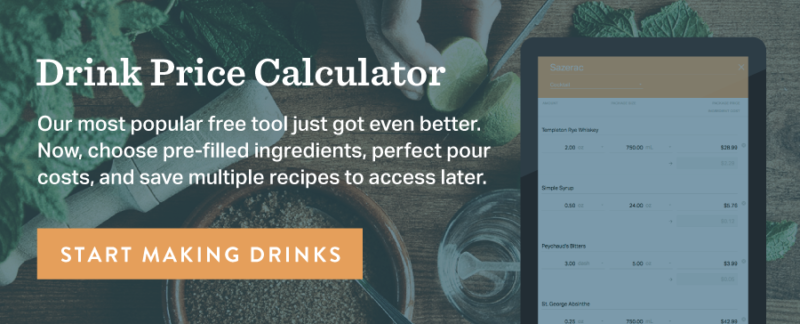
Oaxaca Old Fashioned
Far and away the most ordered and imitated cocktail on the Death & Co. menu, then head bartender Phil Ward created the tequila based version of an old fashioned with a split base of mezcal, becoming one of the first to find a popular home for the, at the time, newly popular spirit. As owner David Kaplan says, the drink “would go on to symbolize our approach to cocktails: a simple recipe grounded in the classics, but with a level of innovation that comes from a deep understanding of the ingredients at play.”
The split base cocktail not just doubles but triples down on the agave flavor, adding in agave nectar along with the tequila and mezcal. A few dashes of angostura bitters and a flamed citrus twist garnish (which was alternatively a chore and a delight to learn for a novice like me) perfect a twist on an old classic.
Manhattan
The Death & Co. manual has three different types of Manhattan. The standard, the citrusy dry manhattan transfer, and the tea-infused black market Manhattan. Of those we went with the standard, which uses traditional angostura bitters. It was strong, sweet, and had a great kick.
While we’ve been been making our own ingredients where we can ever since the Dead Rabbit Drinks Manual, Death & Co. recommend Luxardo Marasche brandied cherries as a garnish, which was a delicious twist that added the perfect balance of fruity sweetness rather than sugary to an absolute classic. Though we do plan on brandying our own cherries in the near future for the experience.
Last Word
The Last Word has a lot going on. Strong gin, the sharp citrus of freshly squeezed lime juice, maraschino liqueur, and green chartreuse together in one glass sounds like the final drink should come up muddled by the strong competing flavors. Somehow though they all play nice together, creating a sharp and citrusy concoction full of fruit with the telltale tastes of juniper and an herbal blend from the gin and chartreuse besides.
After the distinctive flavors of the Oaxaca, and the strength of the Manhattan, the Last Word is refreshing and easy to drink but with its own kick and unique set of flavors that make it stand apart. In short, this easy to make cocktail accomplishes everything in the Death & Co. mission statement. It’s simple. It’s delicious. It’s bold.
The Verdict
The bar has always had a sense of wonder around it. Cocktails have hundreds of years worth of history and myth and mystique around them. There’s no other kind of establishment in the world that does what a bar does. To capture that, even for the span of a night, is a treasure. Death & Co. does that.
It has latched onto and vaulted itself into the lore of a world of strange alchemy. I’m originally a bookseller by trade. We delight in the design of good things, the smells and touch and memory of the things we sell, recommend, agonize over. We know when we’re holding something special. This book is something special. This book is a treasure.
By combing this book’s pages, an astute reader will learn from the ground up the history and use of a dozen types of spirits both common and otherwise. They’ll find a hundred different tools of the trade and their variations from glassware to shakers to ice shaping tools to strainers, and not just the how but the why of each and every one.
Death & Co. Modern Classic Cocktails is a primer, a textbook, and a loving crafted ode to the art of the drink and dedicated men and women who innovate every night. Perhaps the highest compliment I can pay it is the wear already beginning to show, and the assured frequency with which it will be used in the future.
Schedule 15mins to chat with a product specialist
Start a FREE Trial Today! BevSpot offers full product education and account setup for all customers! No card Information needed!
A Beer Director’s Guide to Standing Out Among the Crowd
This article was written by Dave Eisenberg, our newest regular contributor. dave is a seasoned industry writer, working for publications such as good beer hunting and BevNET. Residing within the Boston, MA area, he is looking forward to helping BevSpot readers gain even more insight into the bar and liquor industry.
Photos courtesy of row 34.
It isn’t easy creating a unique, high quality beer program these days, as competition has never been more fierce.
Running a beer-centric bar or restaurant in 2017 might not sound too difficult to the average industry professional. After all, there are more than 5,000 operating breweries in the U.S. alone, many of which are producing world-class beers. And many of them are more than happy to share those beers with any interested retailer, capacity permitting.
But, creating a high quality beer program isn’t as simple as merely serving any given beer that fits the ever-nebulous definition of “craft.” In fact, beer bars are constantly wrestling with choosing the right beers–out of tens of thousands–to pair with their own limited draft lines and fridge space. This presents a bit of a dilemma: How can one create a unique beer program that stands out without sacrificing that which is popular and brings people through the doors?
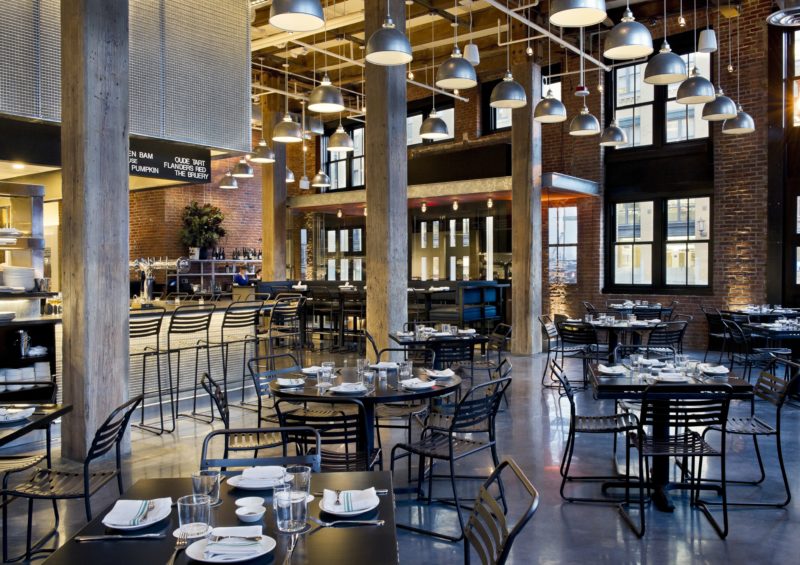
In Boston, Row 34 has built a reputation for its own beer program. At any given time, the restaurant offers a diverse list of sour beers, hop forward ales, Belgian classics, and local stalwarts, all flowing through its 24 draft lines. (It also keeps upwards of 35 bottles at the ready.) Indeed, its commitment to beer has earned the company considerable praise. And, for the past nine months, much of the credit for that goes to Suzanne Hays. As the restaurant’s beer director, she’s in charge of curating its beer selection as well as overseeing beer-related events and education initiatives.
Hays caught up with BevSpot to share with us her philosophy when it comes to creating a unique beer program.
The following has been edited lightly for clarity.
What, in your mind, makes a good beer program?
I would say variety and diversity are kind of what I look for in the beer list, at least at Row 34. When I’m thinking about putting together a sound draft list, for example, I want to make sure there’s variety as far as style and breweries go. And then diversity, too.
I think it’s really important to embrace the sort of local craft beer culture happening in New England, which is so cool. But also taking into consideration some of those breweries that have been around for hundreds of years, thinking of Orval and Weihenstephaner, and Schlenkerla, and finding that happy balance between the old and the new.
You mentioned balance – how do you balance creating a unique and different program while still ensuring you’re keeping the types of beers people want and have come to expect to be available at a good beer bar?
We can take the IPA, for example. There are so many IPAs out there that it can be almost overwhelming to narrow it down. What I like to kind of do is, at one time we’ll have five or six IPAs on. So maybe a feature an East Coast IPA, that sort of New England, hazy IPA, and then feature a West Coast IPA, something that’s a little bit more resinous and dank and piney, and then maybe something from the Midwest that’s got a little bit more malt flavor profile to it.
And sometimes even throwing in an English IPA or something from an upcoming brewery like To Øl, for example, who kind of experiments with the flavor profiles of American beer and puts their own spin on it. Trying to take, if you think about one style in particular, and try to feature the wide range of it, I guess you could say.
Some beer bars go in hard on quantity. You’ll walk in and they’ll have upwards of 50 draft lines or more. Others, meanwhile, commit to a very selective menu, the type of place that has maybe ten lines. Row 34 has 24 lines, 35 bottles. So kind of a healthy medium there. What are your thoughts on sheer volume at beer bars?
Honestly, I think it just depends on what the guests and consumers are looking for. There are of course those times when I go to one of those bars that has 60 or 70 draft lines on and I really enjoy kind of seeing what they find to be relevant or what they have on. And sometimes I’m in the mood to sift through that. Then there are some people, they know what they want, they want one or two things and they go for that and those places that have 10 to 12 draft lines, those work out too.
For me, personally, I love that we have the 24 lines. I think that’s a really nice number. It allows us to have some variety in the list, but without it being overwhelming. What’s important here, we’re kind of given this unique situation in that people come to Row looking for something a little bit different, and I think it could be overwhelming if we had more than 24.
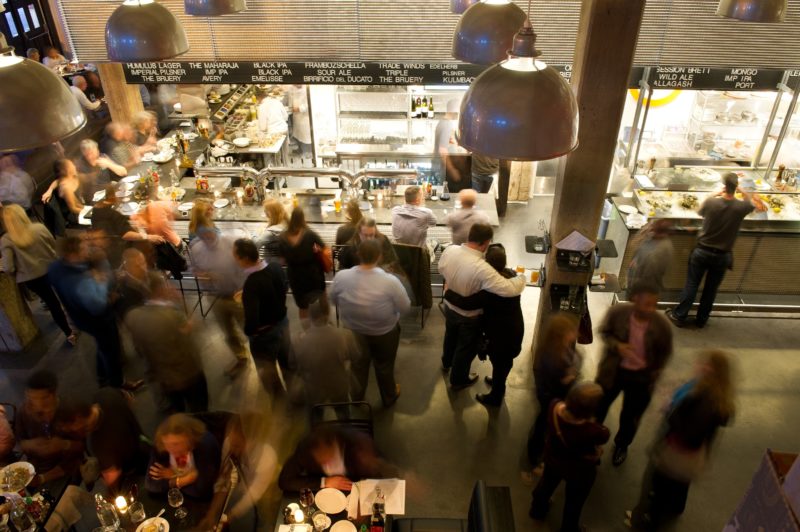
“Sometimes people might be afraid to step outside the box and I think that’s a mistake. I think people should take risks and take chances…”
The craft beer drinker is pretty “promiscuous,” is the word people like to use there, because they tend to jump from brand to brand. Is that something that you can prepare for in advance knowing people aren’t brand loyal, or do you sort of just have to keep rotating and stay ahead of it best you can?
I mean it’s a combination of both. At least at Row, we’re in a spot where we’re doing that already. There really isn’t a beer that we have on all the time, the bottle list excluded. The draft line, we honestly rotate pretty frequently, and you’re not going to find the same beer on all the time.
We don’t really have a consistent line, so I think we’re already kind of preparing ourselves for, as you would say, the “promiscuous drinker,” or someone looking for something a little bit different. But it can be difficult to predict what people are going to be wanting and are coming to expect out of beer bars.
What are some common mistakes or misfires one might make in trying to create a unique beer program?
Sometimes people might be afraid to step outside the box and I think that’s a mistake. I think people should take risks and take chances and, you know, they may not always work out, and that may not be the most popular decision.
But stepping outside your comfort zone and taking a chance on a brewery that’s smaller, or just coming up, or experimenting with a style that you haven’t had in a while, like rauchbier for example, I think that’s often a mistake that people can make when they’re putting something together. They often want only what’s popular and the big names. They want the Cantillons of the world. They want Pliny the Elder. They want those big hitters. After a while, you can only get so much of that. I think that taking risks is really something that not a lot of people are comfortable in doing and I think that’s really where some would fall short.
We live in a time where so many neighboring bars are trying to make their name on their beer selection. How do you stand out? What’s the key?
This is one of those things always in the back of my mind. But honestly, in the forefront of my mind is always what works for us? What’s going to work for Row? The way I try to stay relevant is just researching, drinking new things, tasting new things, listening to my distributors, listening to the staff and friends. I think we set ourselves apart really just by creating something that is authentic to the restaurant itself.

